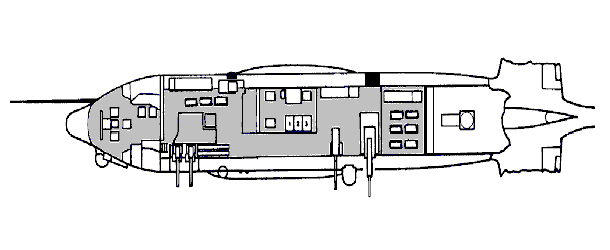
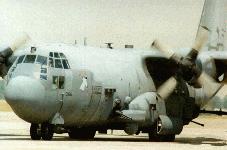
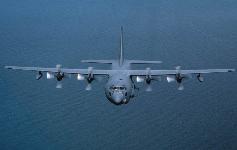
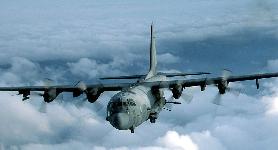
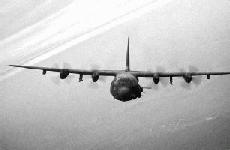
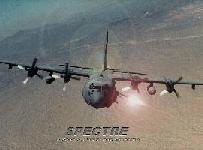
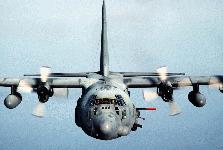
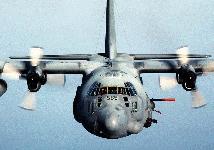
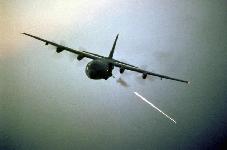
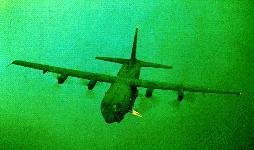



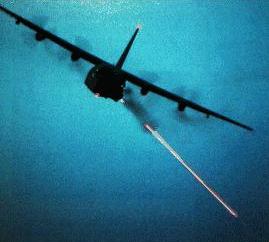
The AC-130H Spectre gunship's primary missions are close air support, air interdiction and armed reconnaissance. Other missions include perimeter and point defense, escort, landing, drop and extraction zone support, forward air control, limited command and control, and combat search and rescue.
These heavily armed aircraft incorporate side-firing weapons integrated with sophisticated sensor, navigation and fire control systems to provide surgical firepower or area saturation during extended periods, at night and in adverse weather.
During Vietnam, gunships destroyed more than 10,000 trucks and were credited with many life-saving close air support missions. AC-130s suppressed enemy air defense systems and attacked ground forces during Operation Urgent Fury in Grenada. This enabled the successful assault of Point Salines airfield via airdrop and airland of friendly forces.
The gunships had a primary role during Operation Just Cause in Panama by destroying Panamanian Defense Force Headquarters and numerous command and control facilities by surgical employment of ordnance in an urban environment. As the only close air support platform in the theater, Spectres were credited with saving the lives of many friendly personnel.
During Operation Desert Storm, Spectres provided air base defense and close air support for ground forces. AC-130s were also used during Operations Continue Hope and United Shield in Somalia, providing close air support for United Nations ground forces. The gunships have most recently played a pivotal role during operations in support of the NATO mission in Bosnia-Herzegovina, providing air interdiction against key targets in the Sarajevo area.
The AC-130 is an excellent fire support platform with outstanding capabilities. With its extremely accurate fire control system, the AC-130 can place 105mm, 40mm and 25mm munitions on target with first round accuracy. The crew of these aircraft are extremely proficient working in military operations in urban terrain [MOUT] environments.
The Air Force commemorated the end of an era 10 September 1995 with the retirement of the first C-130 aircraft to come off a production line. The aircraft, tail number 53-3129, went into production at the Lockheed Aircraft Co. in Marietta, Ga., in 1953 and was the original prototype of what was to become a long line of C-130 Hercules aircraft designed and built by Lockheed. The aircraft, affectionately dubbed "The First Lady," was one of five AC-130A gunship aircraft retired during an official ceremony. While the other four aircraft were sent to the Aerospace Marketing and Regeneration Center at Davis-Monthan Air Force Base, the First Lady went on permanent display at the Eglin Air Force Base Armament Museum. The 919th Special Operations Wing's gunships, all around 40 years old, had reached the age of mandatory retirement. The only other gunships in the Air Force inventory are employed by active-duty members at Hurlburt Field, which has less than 20 gunships assigned.The AC-130H ALQ-172 ECM Upgrade installs and modifies the ALQ-172 with low band jamming capability for all AC-130H aircraft. It also modifies the ALQ-172 with engineering change proposal-93 to provide increased memory and flight line reprogramming capabilities. The Air Force [WR-ALC/LUKA] issued a sole source, fixed price contract, to International Telephone & Telegraph (ITT) for development of low band jammer and subsequent production. Issue a competitive, firm fixed price contract for the Group A modifications (preparing aircraft to receive jammers).
Currently funded weight reduction and center of gravity (CG) improvements to the AC-130H aircraft include: redesign of 40mm and 105mm ammo racks using lighter weight materials; reverse engineering of 40mm and 105mm trainable gun mounts using lighter weight material; and removal of non-critical armor. These efforts are performed by a sole source contract awarded to Rock Island Arsenal.
Continuing the distinguished combat history of side-firing AC-130 gunships, the new AC-130U Spectre gunship is being fielded as a replacement for the AC-130A aircraft. This program acquires 13 new basic C-130H aircraft for modification and integration by Boeing to the AC-130U Gunship configuration. The AC-130U gunship airframe is integrated with an armor protection system (APS), high resolution sensors (All Light Level Television (ALLTV), infrared detection set (IDS) and strike radar), avionics and EW systems, a sophisticated software controlled fire control system, and an armament suite consisting of side-firing, trainable 25mm, 40mm, and 105mm guns. The strike radar provides the first gunship capability for all weather/night target acquisition and strike.
The acquisition program for this new gunship evolved from a Congressional mandate in the mid-1980s to revitalize the special operations force capabilties. Following the contract award to Rockwell in July 1987, the aircraft was first flown on 20 December 1990. FY92 procurement funding was increased to provide the 13th aircraft to replace the AC-130H lost during Desert Storm. Upon completing an exhaustive flight test program at Air Force Flight Test Center from 1991 to 1994 the first aircraft was delivered to AFSOC on July 1, 1994. Boeing’s contract includes: concurrent development, aircraft production, flight test, and delivery. All aircraft have been delivered and the program is transitioning to the sustainment phase. A competitive contract for sustainment was awarded in July 1998.
As a result of the aircraft's success in Operation Enduring Freedom, the Air Force has initiated procurement for 4 additional AC-130U aircraft, to be delivered by FY 2006.
Operation Enduring Freedom saw extensive use of AC-130U "Spooky" aircraft to support special operations and ground forces. Despite being implicated in friendly-fire incidents, the gunships proved crucial to the air campaign because they were able to loiter over the battlefield and strike targets of opportunity. These aircraft benefit from a recent engineering program at the Air Force academy, which determined ways to streamline the AC-130 airframe, decreasing drag, increasing loiter time, and decreasing each aircraft's infrared signature. AFSOC also fit AC-130U aircraft with a video link to download video directly from an orbiting Predator UAV, enabling the gunships to attack targets directly rather than first circling to pinpoint the targets.
The AC-130U is the most complex aircraft weapon system in the world today. It has more than 609,000 lines of software code in its mission computers and avionics systems. The newest addition to the command fleet, this heavily armed aircraft incorporates side-firing weapons integrated with sophisticated sensor, navigation and fire control systems to provide surgical firepower or area saturation during extended loiter periods, at night and in adverse weather. The sensor suite consists of an All Light Level Television system and an infrared detection set. A multi-mode strike radar provides extreme long-range target detection and identification. It is able to track 40mm and 105mm projectiles and return pinpoint impact locations to the crew for subsequent adjustment to the target. The fire control system offers a Dual Target Attack capability, whereby two targets up to one kilometer apart can be simultaneously engaged by two different sensors, using two different guns. No other air-ground attack platform in the world offers this capability. Navigational devices include the inertial navigation system (INS) and global positioning system (GPS). The aircraft is pressurized, enabling it to fly at higher altitudes, saving fuel and time, and allowing for greater range than the AC-130H. Defensive systems include a countermeasures dispensing system that releases chaff and flares to counter radar infrared-guided anti-aircraft missiles. Also infrared heat shields mounted underneath the engines disperse and hide engine heat sources from infrared-guided anti-aircraft missiles.
The AC-130U P3I program develops and procures modifications that correct softwareand hardware deficiencies of the AC-130U fleet discovered during flight tests and that were outside the scope of the original FY86 contract. These modifications will include the following: combine all necessary software requirements for the System Integration Test (SIT) system and hardware and software improvements for the APQ-180 strike radar system; upgrade the Tactical Situation Map; improve core avionics and computers required for the multi-mission advanced tactical terminal/integrated defense avionics system installation; upgrade the EW suite; and modify the software/hardware required for the trainable gun mounts. The Air Force is replacing the 40 mm gun, unique to the AC-130, with the 30mm GAU-8 to alleviate logistic problems.
The AC-130H/U, AAQ-26 Infrared Detection Set (IDS) Upgrade program modifies the optics on the AN/AAQ-17 Infrared Detection Set (IDS) currently installed on 13 AC-130U and 8 AC-130H Gunship aircraft to the AN/AAQ-26 configuration. The AC-130U wiring, Operational Flight Program (OFP), Control Displays Program (CDP), Trackhandle, bus multiplier (BMUX), control panels, and variable slow rate feature will be modified. The AC-130H will also be modified. Support equipment, spares, and tech data for both aircraft will be modified as required to support the AN/AAQ-26 configuration. Mission requirements dictate a significant enhancement in target detection, recognition, and identification ranges to decrease aircraft vulnerability. A sole source fixed price incentive contract was awared to Raytheon for design, modification, and installation; with directed sub to Lockheed Aerospace Systems Ontario (LASO) for integration of the AN/AAQ-26 on the AC-130H and Rockwell for software integration of the AN/AAQ-26 on the AC-130U.
The United States Special Operations Command (USSOCOM) has a requirement for a C-130 engine infrared (IR) signature suppression system to provide Special Operations Forces (SOF) C-130 aircraft with an IR signature reduction equal to or better than existing systems at a lower cost of ownership. The primary difficulties with present suppressor systems are low reliability and poor maintainability. This C-130 Engine Infrared Suppression (EIRS) Program system will be used on AC-130H/U, MC-130E/H/P, and EC-130E aircraft. The key requirements for the Engine IR Suppression system are: (a) improved reliability and maintainability over existing systems to result in lower total cost of ownership; (b) IR signature suppression levels as good as the current engine shield system (aka. Tubs); (c) no adverse impacts to aircraft performance and ability to accomplish SOF missions; (d) complete interchangeability between engine positions and identified aircraft types. The suppressor is expected to be a semi-permanent installation, with removal being primarily for servicing, allowing the aircraft to perform all required missions with the suppressors installed. There will be up to two competitive contracts awarded for the initial phases of development with a downselect to one contractor for the completion of development and production. The contract will contain fixed price options for procurement, installation, and sustainment of the system.
The Directional Infrared Countermeasures (DIRCM) program develops and procures 60 systems and provides 59 SOF aircraft (AC-130H/U, MC-130E/H) with a DIRCM system capability. The DIRCM system will work in conjunction with other onboard self-protection systems to enhance the aircraft’s survivability against currently deployed infrared guided missiles. Growth is planned to add a capability to detect and counter advanced threats. Execution of this program is in concert with a joint US/UK cooperative development/ production effort with the UK as lead. Development and acquisition of the DIRCM system will be in accordance with UK procurement laws/regulations. UK designation for this program is "Operational Emergency Requirements 3/89." In late 1999, Lockheed Martin was awarded the contract to install Northrop Gruman AN/AAQ-24(V) Nemesis DIRCM systems on U.S. Special Operations Command aircraft. The AN/AAQ-24 confuses hostile IR-tracking missiles by directing IR-energy, generated by instense lamps, at the missile's IR seeker. Northrop Gruman announced all manufacturing work associated with the AN/AAQ-24 complete in early 2001. Continuing research associated with the Large Aircraft Infrared Countermeasures (LAIRCM) program will develop a laser-based DIRCM to be fielded later in the decade.
Because of its success during Operation Enduring Freedom, the Air Force has begun considering plans to improve AC-130 and to better fill its primary role. Improvements and replacements must be able to loiter over the battlefield and provide precise, intense firepower on demand more accurately, more effeciently, and more responsively from a platform more survivable than the AC-130. Because the AC-130 flies low and slow, the Air Force worries that the AC-130 is particularly vulnerable to the new SAM threat. Proposals to improve the AC-130 include integrating a stand-off attack capability in the form of Hellfire or JSOW missiles, equipping the AC-130 to control and/or launch UAVs for reconaissance and attack, and replacing the AC-130 with a gunship mounted on a different platform. Suggestions include an AC-17, which would be able to fly higher, fly faster, and carry more payload than the AC-130, and the creation of a new, stealthy airframe. Air Force planners are moving away from the "lone-wolf" mentality of AC-130 gunships operating solo to a "wolfpack" mentality where gunships would control a number of assets, included UAVs, UCAVs, and smart weapons, to coordinate attacks. The next generation gunship may be a flying mothership for UAVs. The AC(X) program is moving into an analysis of alternatives phase.
Specifications | ||||
| AC-130H Spectre | AC-130U Spooky | |||
| Primary Function: | Close air support, air interdiction and armed reconnaissance | |||
| Contractor: | Lockheed Aircraft Corp. | |||
| Power Plant: | Four Allison turboprop engines T56-A-15 | |||
| Thrust: | Each engine 4,910 horsepower | |||
| Length: | 97 feet, 9 inches (29.8 meters) | |||
| Height: | 38 feet, 6 inches (11.7 meters) | |||
| Maximum Takeoff Weight: | 155,000 pounds (69,750 kilograms) | |||
| Wingspan: | 132 feet, 7 inches (40.4 meters) | |||
| Range: | 1,500 statute miles (1,300 nautical miles) Unlimited with air refueling | 2,200 nautical miles Unlimited with air refueling | ||
| Ceiling: | 25,000 feet (7,576 meters) | 30,000 ft. | ||
| Speed: | 300 mph (Mach 0.40) (at sea level) | |||
| Armament: |
two M61 20mm Vulcan cannons with 3,000 rounds one L60 40mm Bofors cannon with 256 rounds one M102 105mm howitzer with 100 rounds |
One 25mm GAU-12 Gatling gun (1,800 rounds per minute) one L60 40mm Bofors cannon (100 shots per minute) one M102 105mm cannon (6-10 rounds per minute) | ||
| Countermeasures |
| |||
| Crew: | 14 -- five officers (pilot, co-pilot, navigator, fire control officer, electronic warfare officer); nine enlisted (flight engineer, loadmaster, low-light TV operator, infrared detection set operator, five aerial gunners) | 13 total. Five officers (pilot, copilot, navigator, fire control officer, electronic warfare officer); 8 enlisted (flight engineer, All Light Level TV operator, infrared- detection set operator, four airborne gunners, loadmaster) | ||
| Unit Cost: | $46.4 million (1992 dollars) | $72 million | ||
| Date Deployed: | 1972 | 1995 | ||
| Inventory: | Active force, 8; Reserve, 0; ANG, 0 | 13 aircraft assigned to 16th Special Operation Wing's 4th Special Operations Squadron. | ||









